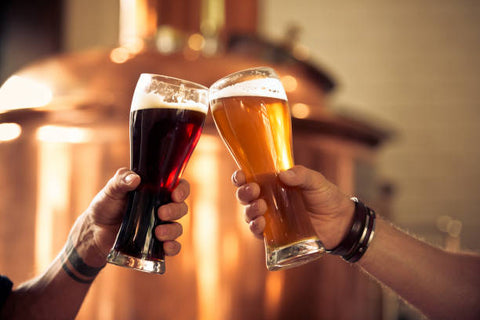
Thanks to the vast world of beer, every bar has countless beverage alternatives. Each beer style gives rise to more subcategories than drinkers know what to do with, from traditional lagers to strong pilsners to funky sour ales.
Craft beer menus at neighbourhood bars have changed from displaying a few familiar brands to presenting unusual drinks; each tastes more sophisticated. Selecting a favourite can be much simpler if you are familiar with several beer types' taste and appearance. And so, for this article, we will compare the three most common beers you have seen often: ale, lager and pilsner. Read along to learn more.
Brewing Beer

Brewing, in its simplest form, controls how water, starch, yeast, and hops combine to produce beer.[1]
Of course, brewing itself is a much more complicated procedure (full of complex terms like lautering, wort, and isomerisation). The brewer is responsible for exerting as much control over as many factors as possible to ensure that the finished product closely resembles what was intended.
Brewing is more about exerting as much control as possible over the outcomes of the fermentation process[2], which is entirely automatic. Because yeast, most frequently of the Saccharomyces cerevisiae or Saccharomyces pastorianius species, enjoys metabolising starch-derived sugars into ethyl alcohol and CO2, we can brew beer (and drink beer and spill beer) for one reason.
When we make beer, we prepare a specific quantity and type of grain to produce those sugars, and then we add yeast so that it may gorge itself and have alcohol.
Three Categories of Brew Beer

All beers fall into one of three categories: ales, lagers, or hybrids. Depending on the yeast used and the fermentation process, they can belong to different categories.[3]
Additionally, when it comes to the variation of beers, the only factor that sets each of them apart is the type of yeast used to ferment the beer. As of now, the most common categories are ale and lager. Top fermentation, in which yeast ferments at warmer temperatures and settles at the top of the beer, is used to make ales.
Lager yeast tends to settle to the bottom of the brew. Therefore, the fermentation process for lager takes longer and occurs at a lower temperature. As opposed to the yeast used in lagers, ales' yeast has a higher tolerance for alcohol.
On the other hand, let's break down the primary details about the three common beer types: ale, lager and pilsner.
1. Ale

Ales are created by traditionally gathering yeast at the top of the fermentation tank. They are usually not aged and ferment at a warmer temperature. Ales make up many craft beers, but not all of them, as they require less time and space to store.[4]
Also, ales have yeast Saccharomyces cerevisiae, which is used in brewing; it ferments throughout the beer and settles at the top of the container. They typically ferment between 60°F to 75°F, which permits the yeast to function quickly. Ales are noted to have deeper, nuanced flavours than lagers and a high alcohol tolerance.
On top of that, ale pre-dates lager and is commonly known to be the oldest type of beer. It has a slightly more assertive and diversified flflavourprofile. It also comes in a wide variety of flavors, including but not restricted to:
- Belgian ale
- Brown ale
- Burton ale
- Cask ale
- Golden ale
- India pale ale
- Mild ale
- Pale ale
- Porters
- Scotch ale
- Stouts
- Wheat Beer
2. Lagers

Lagers differ from ales primarily because the yeast used in their brewing settles to the bottom of the fermentation tank. Moreover, yeast has a lower alcohol tolerance than people do. The flavour that results is smooth, crisp, and light. They often have a lower bitterness than other beers.[5]
Saccharomyces pastorianus yeast, which ferments in the bottom of the vessel, is used to make larger beers. The ideal fermentation temperature for this kind of yeast is between 35°F and 55°F. Because lagers ferment at milder temperatures than ales, the process takes longer. Moreover, lagers typically taste crisper and cleaner than ales.
Also, lager is the more popular type of beer than ale, such as Miller High Life, Stella Artois, Budweiser, PBR, and Coors. Meanwhile, other types of larger are the following:
- Amber lagers
- Bock
- Dark lagers
- Pale lagers
- Pilsners
- Specialty lagers
3. Hybrid Beers

Hybrid beers are often believed that they're either an ale or a lager, but instead, they are a blend of lager and ale and borrow brewing techniques from both types of beer.[6] For example, a lager yeast beer can be produced swiftly and warmly like an ale or fermented at cooler temperatures traditionally reserved for ales - for instance, ale yeast may be used at lager temperatures or vice versa. This method of brewing combines the qualities of both types of beers to produce distinctive flavours that are difficult to categorise. The most examples of hybrid beers are:
- Altbier
- Cream ale
- Kolsch
- Steam beer
Comparisons Between Common Beers
Ale vs. Lager

The main differences between ales and lagers are their different yeast strains and fermentation. Lagers ferment with bottom-fermenting yeast at cold temperatures (35 -50 F) and ales with top-fermenting yeast at warm temperatures (60 -70 F). Ales may typically ferment and age in a short amount of time due to their warm fermentations (3-5 weeks). However, because they are cold fermented, lagers take much longer to ferment (up to 6 to 8 weeks).[7]
Today, it is relatively simple to create both ales and lagers. On the other hand, Ale yeast may make beer in as little as seven days, making it more practical for tiny breweries that may need the fermenter space to manufacture lagers regularly. As a result, ales are often more popular among craft brewers in the contemporary craft beer industry.
Ale vs. Pilsner

Pilsner is a pale lager beer variety with a light colour that ranges from light straw to gold. Saaz hops, which give it a more delicate "touch" and a more hoppy flavour than ordinary Budweiser, makes it famous for its refreshing taste. The strong use of hops in pilsner gives it a flavour that can be described as "spicy."[8]
The most noticeable difference between ale and pilsner is that ales are frequently more bitter, maltier, and hoppier. Meanwhile, pilsners typically taste crisper and cleaner, and they also use various yeast strains during the brewing process.
Lager vs. Pilsner (Beer Yeast)

Pilsner is a style of lager that was first produced in the Czech Republic, but it differs with lager because it primarily uses a distinct type of yeast and has an aggressiveness that utilises hops. Thus, a Pilsner is just a Lager spiced up and given extra hop flavour.
As for lagers, since they call for highly particular conditions in terms of temperature and age times, it is regarded as one of the most challenging beer styles to master in the world of home brewing.
Lagers ferment longer than other types of beer because they use a bottom-fermenting technique. Its clear, crisp flavour comes from the yeast consuming the sugar much more slowly due to the chilly temperatures in the fermentation process.
Simply put, a pilsner is a variety of lager developed significantly later than the traditional lagers.[9]
The pilsner is a light-coloured, extremely golden beer with much foam. The dark lagers have minimal foaming and a very dark colour, sometimes even turning entirely black.
A substantial hop bill is added to the malted barley used to make pilsner today to give it distinctive flavours and smells.
Pilsners are among the most drinkable beer styles and range in strength from 4.5% to 5.2%, depending on the brand.
Recommended Beers Here At Kendricks Familia Imports
Now that we’ve covered everything you need to know about the differences between each beer category, here are our recommended beers for you here at Kendricks Familia Imports that you may enjoy with the rest of your family for any occasion:1. Cruzcampo Gran Reserva Spanish Beer 330ml x 24

Cruzcampo Reserva is a Seville-brewed beer that is the older aged brother of Cruzcampo Pilsner. Compact foam in golden colour with yellow hues. strong malt fragrance with hints of citrus and almonds. Long-lasting hops and a flavour that is both balanced and pleasant. Ideally served in a fine glass at 2-4° C.
Region - Spain - Seville
Grains - Malt, Wheat, Oats and Hops
Alcohol - 6.4%
Size - 0.33
2. Cruzcampo Spanish Beer 330ml x 24

Spanish lager Cruzcampo, brewed in Seville. Everyone will like this Spanish beer because it is a light and pleasant pilsner. roasted malt flavour with a hint of hops, available only in full cases. Buy this now to enjoy a worthwhile meat and grill with the whole family!
Region - Spain - Seville
Grains - Malt, Wheat, Oats and Hops
Alcohol - 5%
Size - 0.33
3. Moritz Spanish Lager 330ml x 24

The taste of Moritz Spanish Lager is light and pleasant, and it is an actual Spanish lager. This lager is brewed using the conventional open-fermentation technique using barley malt and hops from the Penedes region of Spain.
The beer has a light golden color, a bready and slightly sweet flavour, and a mild and hoppy finish. It is ideal for all events, including barbecues and dinner parties. Its 24 bottles make it the perfect way to introduce friends and family to Spanish cuisine.
Region - Barcelona – Spain
Type – Lager
Alcohol - 5%
Size - 0.33
In Conclusion (Making Beer)
All beers are categorised into three; ale, lager and hybrid. This is determined by the fermentation process and the yeast used in brewing, not by colour, flavour, or alcohol content. The esters in ale are the only noticeable distinction between it and a lager. Warm fermentation results in a more outstanding production of these esters. Due to their warm fermentation, they are more prevalent in ales.
We are in the middle of a brewing renaissance, which has provided beer enthusiasts with a wealth of flavour and character in their beer selections. Although lagers are still prevalent, the rise of ales has broadened the palates of many beer lovers and changed the path of beer history for the better. We only have more fantastic beers to look forward to. So, if you're looking for the right beer to enjoy with your family for a special event, shop here at Kendricks Familia Imports!
References:
- https://www.britannica.com/topic/beer
- https://www.ncbi.nlm.nih.gov/pmc/articles/PMC7466055/
- https://hospitalityinsights.ehl.edu/beer-types
- https://www.sevenbro7hers.com/ale-beer-guide/
- https://homebrewadvice.com/types-of-lager-beer
- https://www.northernbrewer.com/blogs/beer-recipes-ingredients/beer-style-guide-hybrid-beers#:~:text=Born%20out%20of%20necessity%2C%20tradition,the%20two%20worlds%20of%20beer.
- https://vinepair.com/beer-101/ale-vs-lager-the-role-of-yeast-in-beer/
- https://time.com/5218581/types-of-beer-guide/
- https://vinepair.com/articles/whats-the-difference-between-pilsner-and-lager/

